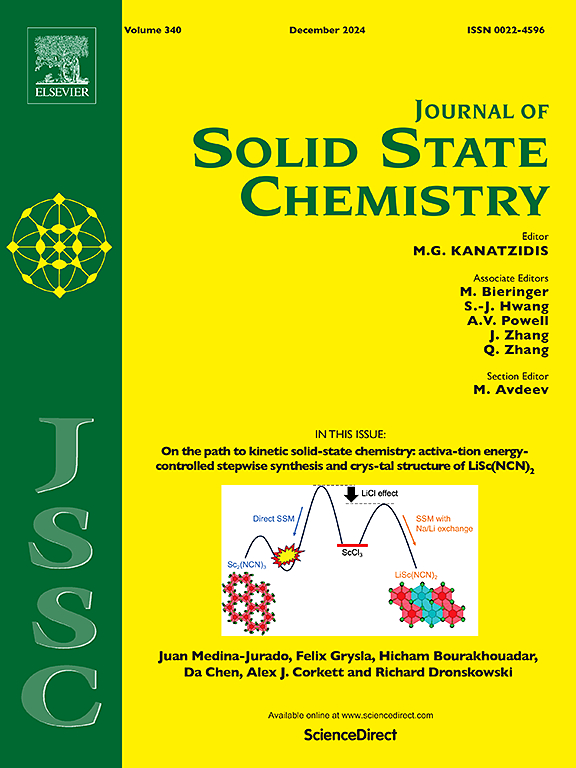Y2(WO4)3·3H2O:xmol%Eu3+荧光粉的热增强发光研究
IF 3.2
3区 化学
Q2 CHEMISTRY, INORGANIC & NUCLEAR
引用次数: 0
摘要
制备了一系列Y2(WO4)3·3H2O:xmol%Eu3+ (YWO:xEu)红色荧光粉。系统地研究了该材料的结构、形态、组成、光致发光特性和热稳定性。当x从0 mol%增加到70 mol%时,样品经历了从正交相到单斜相的结构相变。由于荧光粉的晶相发生转变,带隙能(Eg)、PL强度和荧光衰减寿命发生了显著变化。YWO:5Eu和YWO:20Eu荧光粉在175℃时表现出热增强发光(TEL)。在5D0→7F2转变监测下,最大激发强度分别达到常温下的7.28倍和4.46倍。在CTB激发下,最大发射强度分别是初始发射强度的7.13倍和5.10倍。而YWO:50Eu则表现为发光热猝灭(TQL)。结合原位x射线衍射(XRD)图、Rietveld细化结果、热重(TG)分析和x射线光电子能谱(XPS)数据,可以用H2O分子的释放和Y2(WO4)3的负热膨胀(NTE)来解释TEL的机理。该研究为开发具有热稳定性的高效红色荧光粉提供了指导。本文章由计算机程序翻译,如有差异,请以英文原文为准。

Exploring thermal enhancing of luminescence in Y2(WO4)3·3H2O:xmol%Eu3+ phosphors
A series of Y2(WO4)3·3H2O:xmol%Eu3+ (YWO:xEu) red phosphors were prepared. The structure, morphology, composition, photoluminescent (PL) characteristics, and thermal stability were systematically investigated. The samples underwent a structural phase transformation from the orthorhombic to the monoclinic phase with increasing x from 0 to 70 mol%. Due to the transformation in the crystalline phase of the phosphors, the bandgap energy (Eg), the PL intensity, and the fluorescence decay lifetime exhibited significant change. The YWO:5Eu and YWO:20Eu phosphors exhibited thermal enhancing of luminescence (TEL) at 175 °C. Under the monitoring of 5D0→7F2 transition, the maximum excitation intensities reached 7.28 and 4.46 times of those at room temperature. With CTB excitation, the maximum emission intensities were 7.13 and 5.10 times of the corresponding initial emission intensities. In contrast, YWO:50Eu displayed thermal quenching of luminescence (TQL). Combined with in situ X-ray diffraction (XRD) patterns, Rietveld refinement results, thermogravimetric (TG) analyses, and X-ray photoelectron spectroscopy (XPS) data, the mechanism of TEL can be explained by the release of H2O molecules and the negative thermal expansion (NTE) of Y2(WO4)3. This study provides guidance for exploring efficient red phosphors with thermal stability.
求助全文
通过发布文献求助,成功后即可免费获取论文全文。
去求助
来源期刊

Journal of Solid State Chemistry
化学-无机化学与核化学
CiteScore
6.00
自引率
9.10%
发文量
848
审稿时长
25 days
期刊介绍:
Covering major developments in the field of solid state chemistry and related areas such as ceramics and amorphous materials, the Journal of Solid State Chemistry features studies of chemical, structural, thermodynamic, electronic, magnetic, and optical properties and processes in solids.
 求助内容:
求助内容: 应助结果提醒方式:
应助结果提醒方式:


